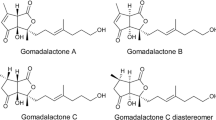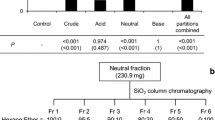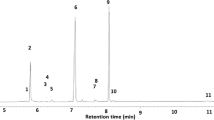Abstract
Because of its special biological features, the leaf-cutter bee Megachile rotundata is particularly well suited for breeding and use as a pollinator for fodder plants such as alfalfa. Its mating behavior has been extensively studied. Behavioral tests have shown that males explore any black spot as a potential mating partner. However, exclusive selection of young virgin females suggests involvement of olfactory cues in addition to visual stimuli. Experiments demonstrated that mating behavior could be induced in males by lures covered with pentane extracts of the epicuticular waxes of young females. These extracts contain 35% fatty acids, 26% alkanes, and 39% monoenes. Variations in the monoene subfraction allow distinction between young virgin females, which possess more 7-pentacosene and 9-pentacosene, and older females, which have more 5-monoenes. The findings show that male mate-seeking and copulatory activity is stimulated only by young female monoenes. A 40% increase in this activity was observed.
Similar content being viewed by others
REFERENCES
Alcock, J., Jones, C. E., and Buchman, S. L. 1976. Location before emergence of the female bee, Centris pallida, by its male (Hymenoptera: Anthophoridae). J. Zool. London 179:189-199.
Attygalle, A. B., Vostrowsky, O., Bestmann, H. J., and Morgan, E. D. 1986. New chemicals from the Dufour gland of the Formicine ant Lasius niger (Hymenoptera: Formicidae). Insect Biochem. 17:219-225.
BagnÈres, A.-G., Errard C., Mulheim, C., Joulie, C., and Lange, C. 1991. Induced mimicry of colony odors in ants. J. Chem. Ecol. 17:1641-1664.
Barrows, E. M. 1975. Mating behavior in halictine bees (Hymenoptera: Halictidae): III. Copulatory behavior and olfactory communication. Insectes Soc. 22:307-332.
Bergmark, L., Borg-Karlson, A.-K., and TengÖ, J. 1984. Female characteristics and odor cues in mate recognition in Dasypoda altercator (Hym., Melittidae). Nova Acta Regiae Soc. Sci. Ups., Ser. V: C 3:37-143.
Bjostad, L. B., Wolf, W. A., and Roelofs, W. L., 1987. Pheromone biosynthesis in Lepidopterans: Desaturation and chain shortening, pp. 77-120, in G. L. Prestwich and G. J. Blomquist (eds.). Pheromone Biochemistry. Academic Press, New York.
Blomquist, G. J., Chu, A. J., and Remaley, S. 1980. Biosynthesis of wax in the honeybee, Apis mellifera L. Insect Biochem. 10:313-321.
Blomquist, G. J., Nelson, D. R., and deRenobales, M. 1987. Chemistry, biochemistry, and physiology of insect cuticular lipids. Arch. Insect Biochem. Physiol. 6:227-265.
Bohart, G. E. 1972. Management of wild bees for the pollination of crops. Annu. Rev. Entomol. 17:287-312.
Butler, C. G. 1965. Sex attraction in Andrena flavipes (Hymenoptera: Apidae), with some observations on nest-site restriction. Proc. R. Entomol. Soc., London 40A:77-80.
Cane, J. H., and Tengo, J. 1981. Pheromonal cues direct mate-seeking behavior of male Colletes cunicularius (Hymenoptera: Colletidae). J. Chem. Ecol. 7:427-436.
Carlson, D. A., Langley, P. A., and Huyton, P. 1971. Sex pheromone of the house fly: Isolation, identification, and synthesis of contact aphrodisiacs. Science 201:750-753.
Carlson, D. A., Roubik, D. W., and Milstrey, K. 1991. Distinctive hydrocarbons among giant honey bees, the Apis dorsata group (Hymenoptera: Apidae). Apidologie 22:169-181.
Finidori-Logli, V., BagnÈres, A.-G., Erdmann, D., Francke, W., and ClÉment, J.-L. 1996. Sex recognition in Diglyphus isaea Walker (Hymenoptera: Eulophidae): Role of an uncommon family of behaviorally active compounds. J. Chem. Ecol. 22:2063-2079.
Francis, G. W., and Veland, K., 1981. Alkylthiolation for the determination of double-bond positions in linear alkenes. J. Chromatogr. 219:379-384.
Francis, B. R., Blanton, W. E., and Nunamaker, R. A., 1985. Extractable surface hydrocarbons of workers and drones of the genus Apis. J. Apic. Res. 21:13-26.
Francis, B. R., Blanton, W. E., Littlefield, J. L., and Nunamaker, R. A. 1989. Hydrocarbons of the cuticle and hemolymph of the adult honey bee (Hymenoptera: Apidae). Ann. Entomol. Soc. Am. 82:486-494.
Free, J. B. 1971. Stimuli eliciting mating behavior of bumble bee (Bombus pratorum L.) male. Behaviour 40:55-61.
Gary, N. E. 1962. Chemical mating attractant in queen honeybee. Science 136:773-774.
Gerber, H. S. 1969. Factors affecting the sex ratio and nesting behavior of Megachile rotundata (Fab.) (Hymenoptera: Megachilidae). PhD Thesis. Washington State University.
Hadley, N. F., Blomquist, G. J., and Lanham, U. N. 1981. Cuticular hydrocarbons of four species of Colorado Hymenoptera. Insect. Biochem. 11:173-177.
Howard, R. W. 1993. Cuticular hydrocarbons and chemical communication, pp. 179-226, in D. W. Stanley-Samuelson and D. R. Nelson (eds.). Insect Lipids. University of Nebraska Press, Lincoln.
Klostermeyer, E. C. 1982. Biology of the Alfalfa leafcutting bee, pp. 10-19, in G. H. Rank (ed.) Proceedings of the First International Symposium on Alfalfa Leafcutting Bee Management. August 16–18, 1982, University of Saskatchewan, Saskatoon, Canada.
Kullenberg, B. 1956. Field experiments with chemical sexual attractants on aculeate Hymenoptera males. Zool. Bidr. Uppsala 31:253-352.
Kullenberg, B. 1973. Field experiments with chemical sexual attractants on aculeate Hymenoptera males, II. Zoon Suppl. 1:31-42.
Lockey, K. H. 1988. Lipids of the insect cuticle: Origin, composition and function. Comp. Biochem. Physiol. 89B:595-645.
McGregor, S. E. 1976. Insect pollinization of cultivated crop plants. Agriculture Handbook No. 496. U.S.D.A., Washington, D.C.
McDaniel, C. A., Howard, R. W., Blomquist, G. J., and Collins, A. M. 1983. Hydrocarbons of the cuticle, sting apparatus, and sting shaft of Apis mellifera L. Identification and preliminary evaluation as chemotaxonomic characters. Sociobiology 8:287-298.
Meyer-Holzapfel, M. von 1984. Zur ethologie des Männchens der trugbiene (Panurgus banksianus Kirby) (Hymenoptera: Apidae). Z. Tierpsychol. 64:221-252.
Oldham, N. J., Billen, J., and Morgan, E. D. 1994. On the similarity of the Dufour gland secretion and the cuticular hydrocarbons of some bumblebees. Physiol. Entomol. 19:115-123.
Pain, J., and Ruttner, F. 1963. Les extraits des glandes mandibulaires des reines d'abeilles attirent les mâles durant le vol nuptial. C.R. Acad. Sci. Paris 256:512-515.
Raw, A. 1976. The behavior of males of the solitary bee Osmia rufa (Megachilidae) searching for females. Behaviour 56:279-285.
Schwartz, D. 1988. Méthodes Statistiques à l'Usage des Médecins et Biologistes. Flammarion, Paris.
Scribe, P., Guezennec, J., Dagaut, J., Pepe, C., and Saliot, A. 1988. Identification of the position and the stereochemistry of the double bond in monounsaturated fatty acid methyl esters by gas chromatography/mass spectrometry of dimethyl disulfide derivatives. Anal. Chem. 60:928-931.
Shimron, O., and Hefetz, A. 1985. Mating behavior and sex attraction of Eucera palestinae Friese (Hymenoptera: Anthophoridae). J. Kans. Entomol. Soc. 58:526-531.
Siegel, S. 1956. Nonparametric Statistics for the Behavioral Sciences. McGraw-Hill, New York.
Singer, T. L., 1998. Roles of hydrocarbons in the recognition systems of insects. Am. Zool. 38:394-405.
Smith, B. H., and Ayasse, M. 1987. Kin-based male mating preferences in two species of halictine bee. Behav. Ecol. Sociobiol. 20:313-318.
Smith, B. H., Carlson, R. G., and Frazier, J. 1985. Identification and bioassay of macrocyclic lactone sex pheromone of the halictine bee Lasioglossum zephyrum. J. Chem. Ecol. 11:1447-1456.
Stephen, W. P., and Torchio, P. F. 1961. Biological notes on the leaf-cutter bee Megachile (Eutricharaea) rotundata (Fabricius). Pan-Pac. Entomol. 37:85-93.
Still, W. C., Kahn, M., and Mitra, A. 1978. Rapid chromatographic technique for preparative separations with moderate resolution. J. Org. Chem. 43:2923-2925.
Szabo, T. I., and Smith, M. V. 1972. The influence of light intensity and temperature on the activity of the alfalfa leaf-cutter bee Megachile rotundata under field conditions. J. Apic. Res. 11:157-165.
TasÉi, J.-N., and CarrÉ, S., 1984. Élevages de Mégachiles en France. Notice technique I.N.R.A., Lusignan, France.
TengÖ, J. 1979. Odour-released behavior in Andrena male bees (Apoidea, Hymenoptera). Zoon 7:15-48.
TengÖ, J., Eriksson, J., Borg-Karlson, A.-K., Smith, B. H., and Dobson, H. 1988. Mate-locating strategies and multimodal communication in male mating behavior Panurgus banksianus and P. calcarata. J. Kans. Entomol. Soc. 61:388-395.
Velthuis, H. H. W., and Gerling, D. 1980. Observations on territoriality and mating behavior of the carpenter bee Xylocopa sulcatipes. Entomol. Exp. Appl. 28:82-91.
Wcislo, T. W. 1992. Attraction and learning in mate-finding by solitary bees, Lasioglossum (Dialictus) figueresi Wcislo and Nomia triangulifera Vachal (Hymenoptera: Halictidae). Behav. Ecol. Sociobiol. 31:139-148.
Zagatti, P. 1985. Approche Evolutive du Comportement Précopulatoire chez les Lépidoptères Ditrysiens. PhD Thesis. Université Pierre et Marie Curie, Paris.
Author information
Authors and Affiliations
Rights and permissions
About this article
Cite this article
Paulmier, I., Bagnères, AG., Afonso, C.M.M. et al. Alkenes as a Sexual Pheromone in the Alfalfa Leaf-Cutter Bee Megachile rotundata . J Chem Ecol 25, 471–490 (1999). https://doi.org/10.1023/A:1020993518226
Issue Date:
DOI: https://doi.org/10.1023/A:1020993518226




